Hyperliquid is a leading decentralized perpetual contract exchange that has quietly captured 13.6% of Binance's monthly perpetual contract trading volume, generating $116 million in monthly revenue, of which 97% is returned to ecosystem participants.
Author | Joey @IOSG
In recent months, Hyperliquid has gained significant attention. This article aims to inform everyone about the latest developments and future expectations. It serves as both an introductory guide to Hyperliquid and includes some detailed insights into the overall ecosystem.
TL;DR
For readers who just want to know the key points and highlights of this article:
Hyperliquid has quietly captured 13.6% of Binance's monthly perpetual contract trading volume, generating $116 million in monthly revenue—but most analyses overlook the subtle risk/reward dynamics that will determine whether it becomes a groundbreaking infrastructure project in the cryptocurrency space or another casualty of DeFi.
Market Position
Accounts for 70% of total decentralized perpetual contract trading volume, with daily trading volume representing 9.9% of Binance's.
665,000 traders generate an average trading volume of $300,000 per person per month (trading intensity is 65 times that of Binance retail users).
$4.4 billion USDC on the platform accounts for 71% of the total USDC locked on Arbitrum.
Fundamentals
Monthly revenue of $116 million, with 97% returned to ecosystem participants.
38% of the total token supply (388 million HYPE) is still reserved for future growth incentives.
24 validator nodes maintain network security vs. over 1 million on Ethereum (a trade-off between centralization and performance).
Competitive Landscape
An estimated 15-25% of wash trading (better than industry standards but still requires attention).
Market share of Binance's perpetual contracts grew from 2.2% to 13.6% within 12 months.
Jupiter platform recorded $32 billion in perpetual contract trading volume over 60 days, indicating increased on-chain competition.
While most people focus on token price appreciation, I analyze its underlying business sustainability through multiple market cycles (including bear market stress tests and competitive pressures).
The unlocking of 238 million tokens starting at the end of the year will create an average daily selling pressure of $17 million—equivalent to 8 times the current buyback capacity, a structural resistance that most bulls overlook.
$600 million in Nasdaq-listed treasury allocations and VanEck endorsements indicate non-retail demand may absorb unlocking pressure, but the timeline for institutional adoption remains uncertain.
Zero gas fee trading + 0.2-second latency + built-in order book create switching costs, but technical debt and consensus mechanism limitations may erode advantages.
Hyperliquid may face user attrition due to token depreciation and revenue compression, but the 97% fee return model and sustainable revenue generation capability make it a potentially multi-cycle infrastructure project.
Unlike traditional DeFi protocols that rely on token emissions or subsidized yields, Hyperliquid generates revenue from real economic activity and almost fully returns it—showing resilience when unsustainable yield models collapse.
A 60-80% decline is expected during the unlocking period from 2025 to 2027, but business acumen and infrastructure advantages position it to emerge strongly during industry consolidation.
This article points directly to the key factors that will determine Hyperliquid's long-term success: sustainable business model, competitive positioning, and the ability to survive multiple cycles during an industry-wide crisis.
Wat Happen?

The well-known part—Hyperliquid is a leading decentralized perpetual contract exchange (Perpetual DEX) and is seeking vertical expansion. It accounts for 60% of the trading volume in the decentralized perpetual contract market, driven primarily by regulatory arbitrage opportunities, airdrop activities, excellent user interface/user experience (UI/UX), deep liquidity, and strong community consensus.
Initial Growth
Users can access a perpetual contract exchange with a seamless UI/UX without undergoing KYC (but still need to comply with regulations in different regions). This is made possible by:
Zero Gas Fees and Low Trading Costs
A unique order cancellation and post-only priority mechanism, superior to other order types (such as Immediate or Cancel IOC), significantly reduces the harmful effects of high-frequency trading (HFT) grabbing orders (by more than 10 times). For more technical details on how this is achieved, you can read the explanation about precompiles:
x.com/emaverick90/status/1919727174426284488
Intuitive Interface
One-click DeFi operations.
Lightning-Fast Trading Experience
0.2-second block time, achieving 20,000 TPS on-chain through a unique consensus model.
Excellent Market Makers and Liquidity Providers
Initially guided by the Hyperliquid core team.
In a cryptocurrency world where everyone is eagerly seeking convenient leverage channels (such as meme coins, prediction markets, derivatives, and altcoin betas) during a bull market, perpetual contracts have found their footing as the simplest way to access leverage, achieving product-market fit (PMF).
Airdrop
Subsequently, their airdrop began distribution—this airdrop covered nearly 94,000 wallets, with each participant receiving HYPE tokens worth an average of $45,000 to $50,000:
No selling pressure from insiders.
Broad user holdings promote loyalty and alignment of interests.
Notably, the Hypios community also provided extremely generous airdrops to its holders, and even meme coins on Hyperliquid (such as $BUDDY, $PURR) maintained low selling pressure and strong holders.
As traders/DeFi deep participants received tokens, many chose to stake (to reduce trading fees) and deposit into the HLP vault (https://hyperliquid.gitbook.io/hyperliquid-docs/hypercore/vaults/protocol-vaults), enhancing the trading experience and initiating a strong flywheel effect.

Heavy users continued to actively use their newly acquired wealth—fee income was used to buy back tokens—reinforcing product and market influence—Hyperliquid attracted more users and trading volume.
As a result, this large-scale distribution allowed HYPE to avoid the common price drop after an airdrop. In fact, in the following months, HYPE's price soared by 1,179%—from $3.90 at launch in November 2024 to $47 in August 2025.
The HyperEVM
On February 18, HyperEVM was officially launched.

▲ Source: ASXN
It is not an independent chain but secured by the same HyperBFT consensus mechanism as HyperCore. Both share state and essentially use a version of the Cancun hard fork without blobs.
Developers can now access a mature, liquid, and high-performance on-chain order book. For example, a project can deploy an ERC20 contract on HyperEVM using standard EVM development tools and deploy the corresponding spot asset in the HyperCore spot auction without permission. Once linked, users can use the token in applications on HyperEVM and trade on the same order book.
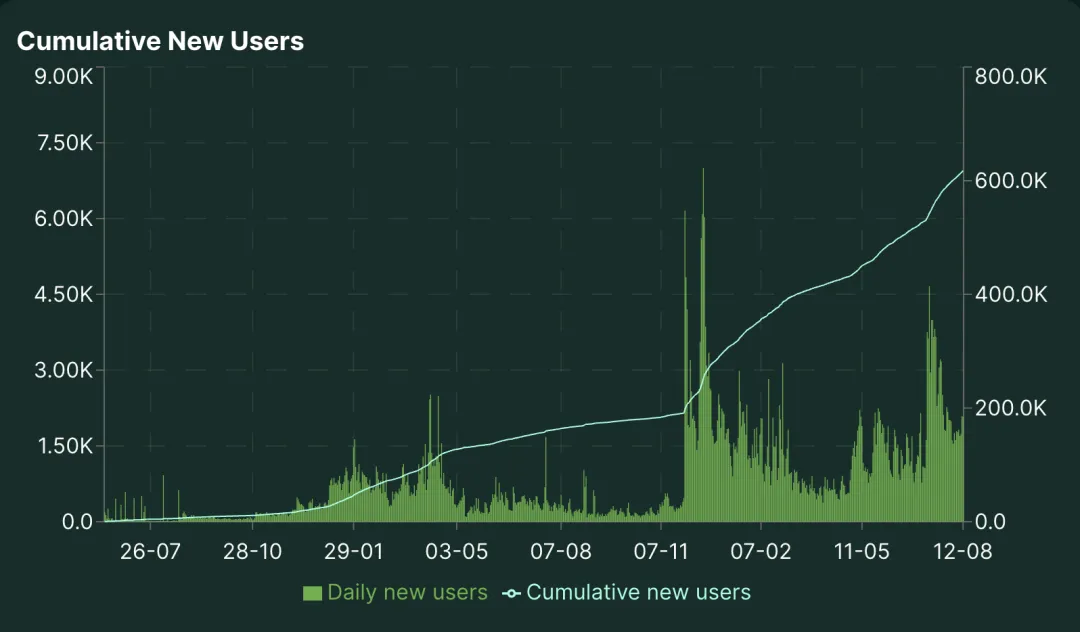
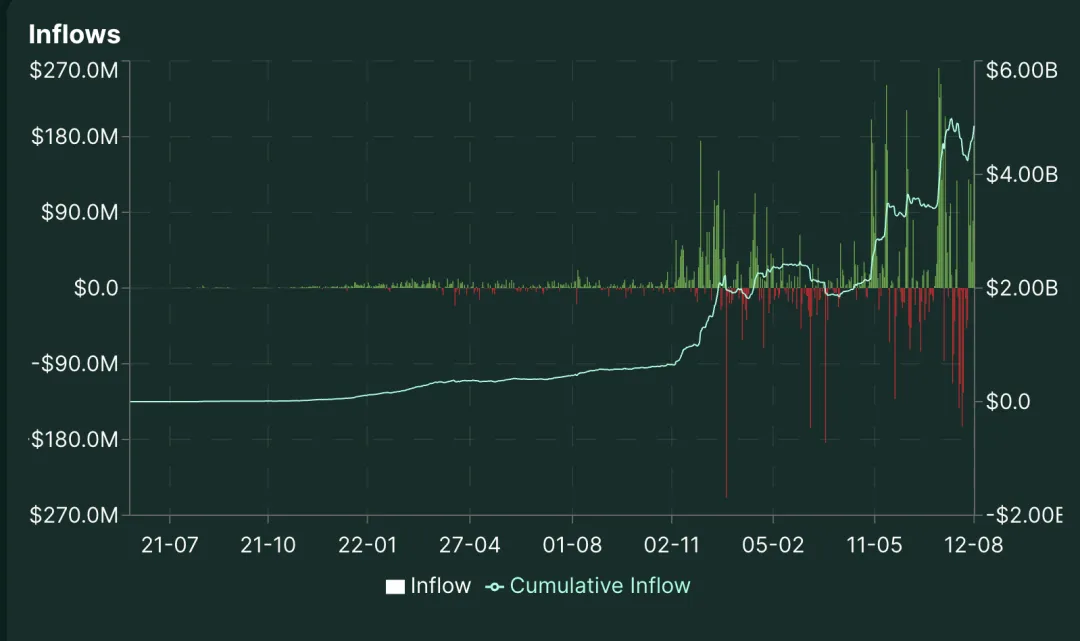
This enhances the power of developers and the community by supporting a wider range of use cases. It allows a large user base and liquidity aligned with Hyperliquid to further leave their mark in the ecosystem. It also improves liquidity by providing a composable, programmable layer, opening another avenue for Hyperliquid's usage to flow back to participants.
Notably, this also provides a pathway for projects outside the Hyperliquid ecosystem to join. For example, Pendle has now integrated with HyperBeat and Kinetiq's LST and LoopedHYPE's WHLP & LHYPE (https://x.com/looping_col/status/1955645499970560311). EtherFi and HyperBeat are launching preHYPE (https://thedefiant.io/news/defi/etherfi-expands-to-hyperliquid-ecosystem-through-collaboration-with-hyperbeat). Morpho offers a treasury on HyperBeat, with top curators including MEV Capital, Gauntlet, Re7 labs, and many other institutions.
The network effects of HyperEVM are not about cloning or EVM compatibility; the core lies in creating a programmable financial operating system where code, liquidity, and incentives are natively aligned and instantly accessible. Liquidity does not fragment; instead, it multiplies as more use cases, yield sources, and protocols are integrated. As the entire tech stack enriches, both users and developers benefit, making the Hyperliquid ecosystem the "gravity center" of future DeFi.
Wat Now?
Hyperliquid has all the necessary liquidity and infrastructure in an ecosystem filled with financialized individuals—whether they are farmers, quantitative traders, developers, or traders. So, how can it expand outward on this foundation?
Builder Codes
Hyperliquid has launched Builder Codes (learn more: https://hyperliquid.gitbook.io/hyperliquid-docs/trading/builder-codes), allowing the platform to connect to any distribution channel and enabling the integrators to receive a share of the fees. For the Phantom wallet, which has 17 million users, this is undoubtedly a great opportunity to expand wallet use cases and increase revenue.

Overview of HIP Proposals
Moreover, Hyperliquid Improvement Proposals (HIP1, 2, 3) further promote the vertical deepening of the tech stack.
HIP-1 is a standard for deploying native tokens and on-chain spot order books.
Learn more: https://hyperliquid.gitbook.io/hyperliquid-docs/hyperliquid-improvement-proposals-hips/hip-1-native-token-standard
HIP-2 aims to permanently inject liquidity into the spot order book for HIP-1 tokens.
Learn more: https://hyperliquid.gitbook.io/hyperliquid-docs/hyperliquid-improvement-proposals-hips/hip-2-hyperliquidity
The Unit project has strongly driven the adoption of HIP-2 by providing a more native spot trading experience. Essentially, Unit is a multi-signature wallet that allows traders to index the native chain and trade on Hyperliquid without permission. (Learn more: https://docs.hyperunit.xyz/)

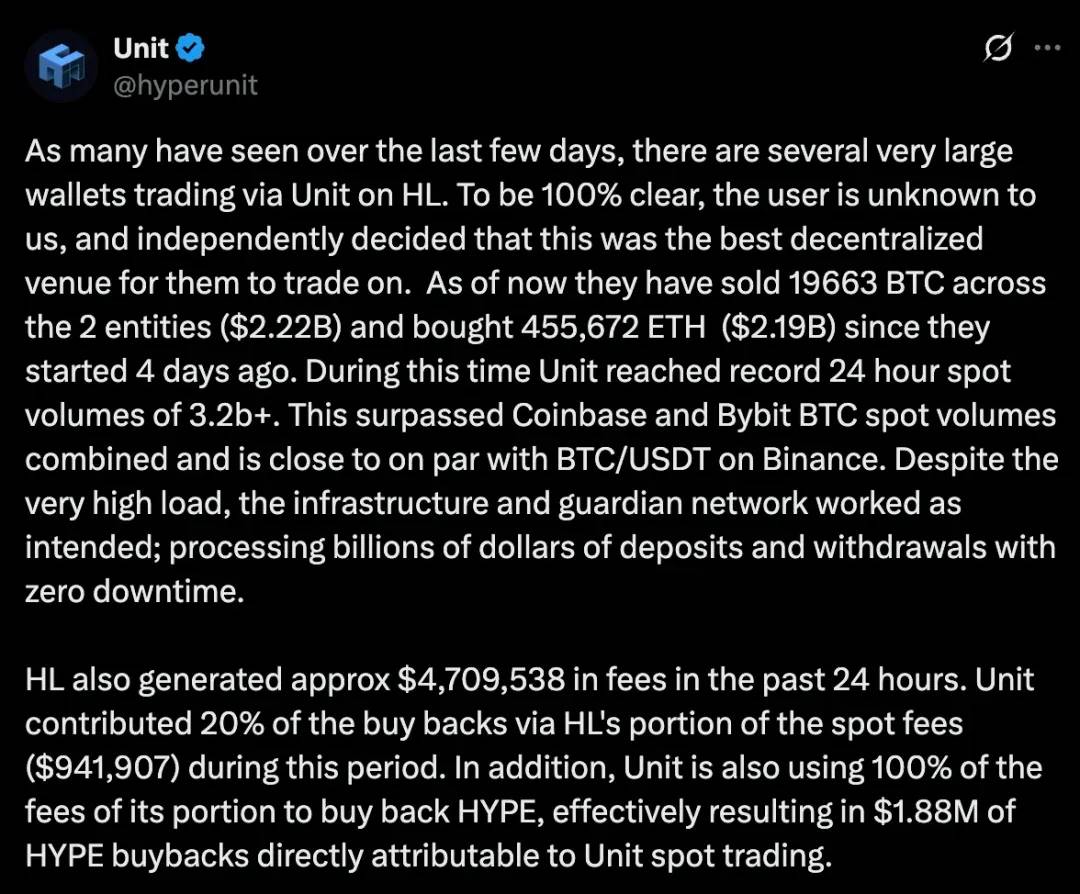
However, the update that arguably generated the most buzz is HIP-3: https://hyperliquid.gitbook.io/hyperliquid-docs/hyperliquid-improvement-proposals-hips/hip-3-builder-deployed-perpetuals
HIP-3 introduces a permissionless, developer-deployed perpetual contract market on the core infrastructure. Before HIP-3, only the core team could launch perpetual contract markets, but now anyone who stakes 1 million HYPE can directly deploy their own market on-chain.
The process is as follows:
Stake 1 million HYPE.
Define market details: market name and code (still need to be purchased through auction, similar to spot), choose collateral type, oracle source and fallback logic, leverage and margin parameters, contract specifications, and funding mechanisms.
Set up the fee structure (establish base trading fees and any additional custom fees), determining the fee-sharing ratio for the market deployer (up to 50%).
Similar to the revenue-sharing relationship between Binance and Circle.
Deploy the market.
Market operators need to guide liquidity themselves, while Hyperliquid receives an additional 50% of the fees (this portion will flow back to the HYPE token). It is important to note that these markets will not appear directly on the Hyperliquid main interface, but anyone can choose which markets to connect to. This shifts Hyperliquid's role from merely a launch platform to more of an asset provider.
So far, Hyperliquid has successfully conquered the following core areas:
High-performance trading engine: providing a trading experience that effectively mimics the performance of centralized exchanges for both spot and perpetual contracts.
This includes leverage trading and spot transfer functions.
Combines consumer-grade user experience with distribution channels.
EVM as a programmable execution layer: built a programmable layer (HyperEVM) closely linked to user experience and liquidity centers.
Stablecoin infrastructure: successfully attracted $5.6 billion worth of USDH into its ecosystem.
There are still vast opportunities for exploration for Hyperliquid itself or other projects in its ecosystem (based on HyperEVM):
Native fiat on/off ramp: build a more convenient and low-cost bridge for fiat and cryptocurrency conversion.
Payment solutions: develop new payment applications utilizing its high-speed, low-cost network.
Web2-level consumer applications: develop complex decentralized products that offer experiences comparable to traditional Web2 applications to attract a broader user base.
Risk management engine: create better risk management and hedging tools for institutions and advanced traders.
Current Status of Tokens/Liquidity
The buyback program led by the Assistance Fund shows that 28 million HYPE have been repurchased to date, funded by 54% of total revenue (46% of perpetual contract fees are allocated to HLP depositors, meaning 92-97% of total revenue is returned to users), with an average daily buyback amount of $2.15 million.
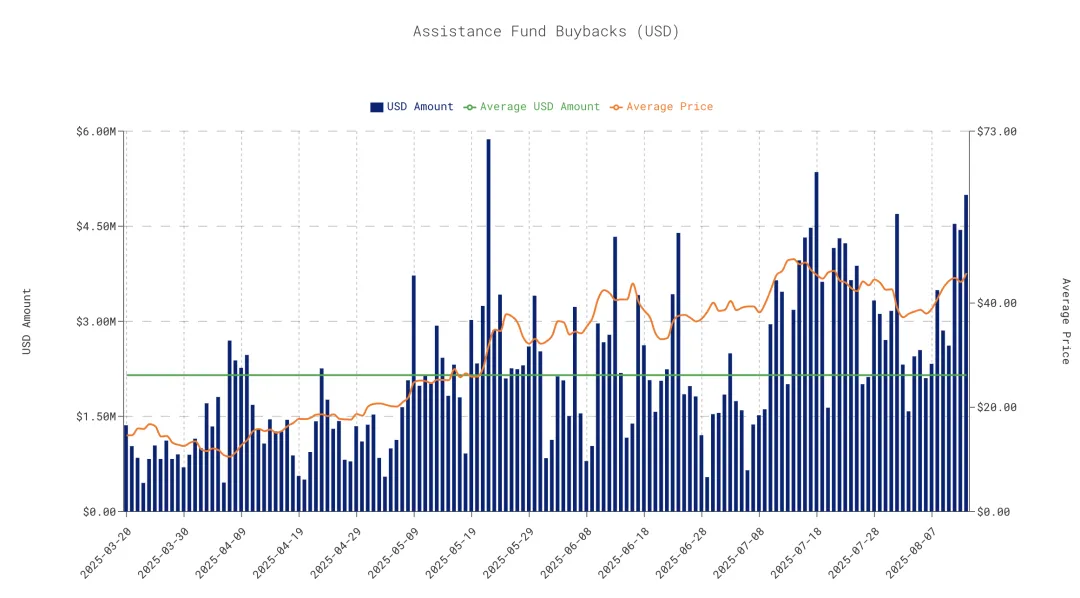
Currently, 38% of the total supply of 1 billion HYPE is still specifically reserved for airdrops and incentives, which has the potential to further drive ecosystem usage. However, this is a double-edged sword, as such a significant increase in circulating supply could create enormous selling pressure far exceeding current buyback capacity.
In terms of USDC inflow, Hyperliquid continues to grow, with a current stock of approximately $4.4 billion. Surprisingly, this accounts for 71.11% of the total USDC locked on Arbitrum, and these funds are being used within the Hyperliquid ecosystem.

Using non-HLP trading volume metrics (totaling $4.3 trillion) for analysis, since HLP acts as a passive liquidity provider/platform fund pool responsible for internalizing order flow and hedging risks, non-HLP trading volume represents user-to-user (Peer-to-Peer) trading flow. It is worth noting that this user-to-user trading flow still includes:
Market makers.
Approximately 20% of regular trading mining accounts and treasury accounts employing systematic strategies (see appendix).
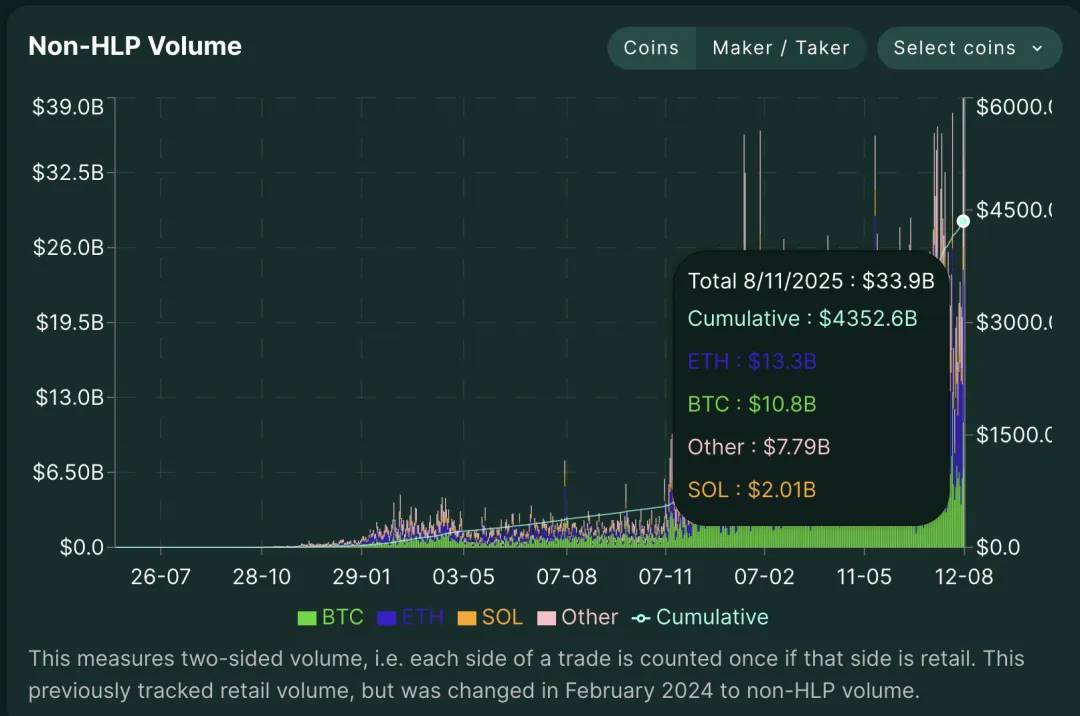
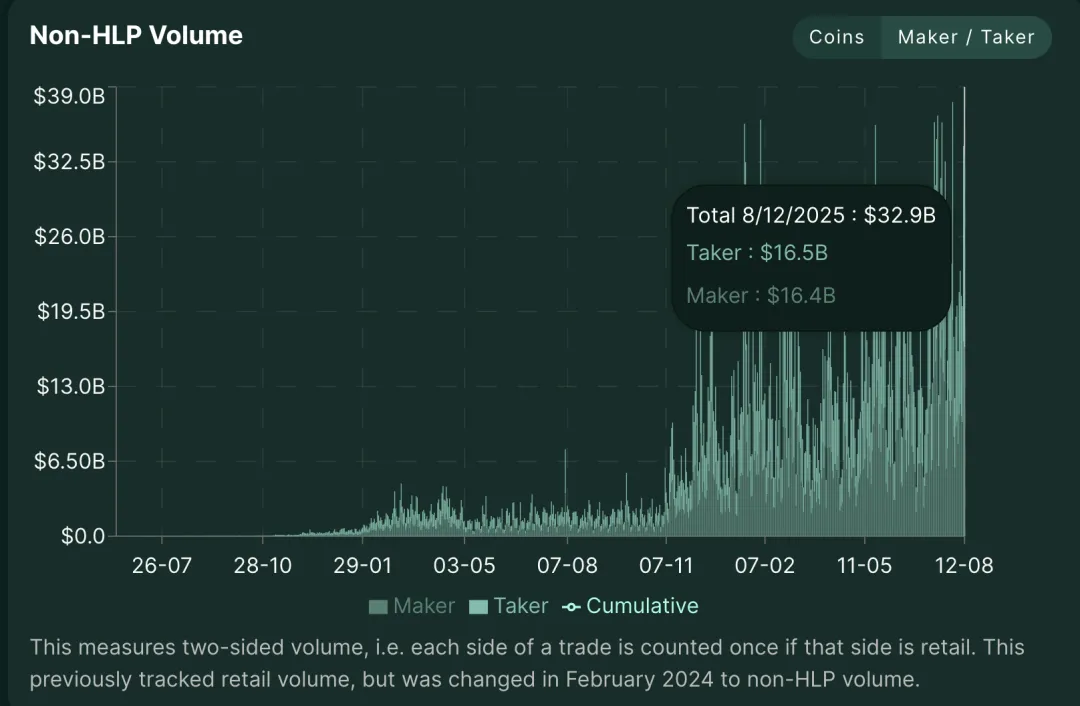
For an exchange, an increase in market makers is a "sweet trouble." In fact, Jeff has mentioned that the number of market makers has become "too many."
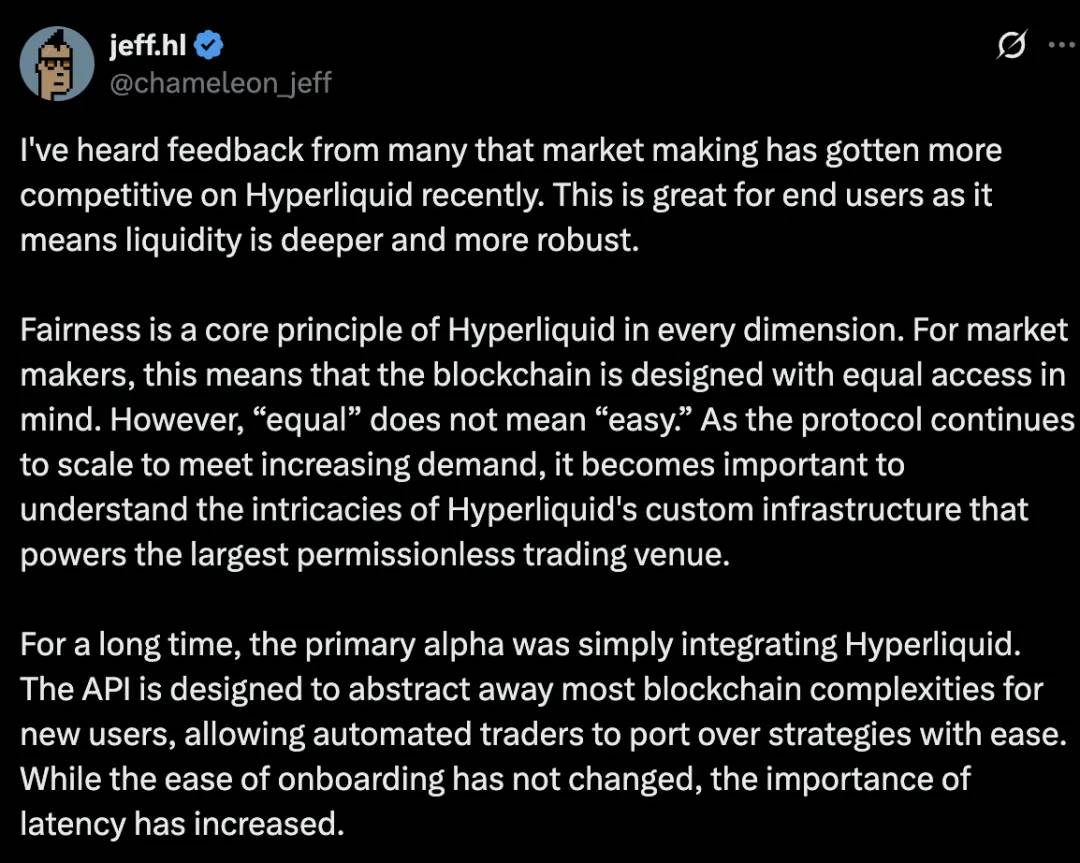
As of the analysis date, the number of daily unique traders is 46,925. Statistics show that the percentage sum of the assets traded by users exceeds 100% because one address trades multiple assets. This multi-asset overlapping trading indicates that Hyperliquid is not just a single-asset trading venue—traders interact with multiple assets per session, reflecting extremely high platform stickiness and cross-asset speculative behavior. Meanwhile, the number of traders on Hyperliquid is steadily increasing.
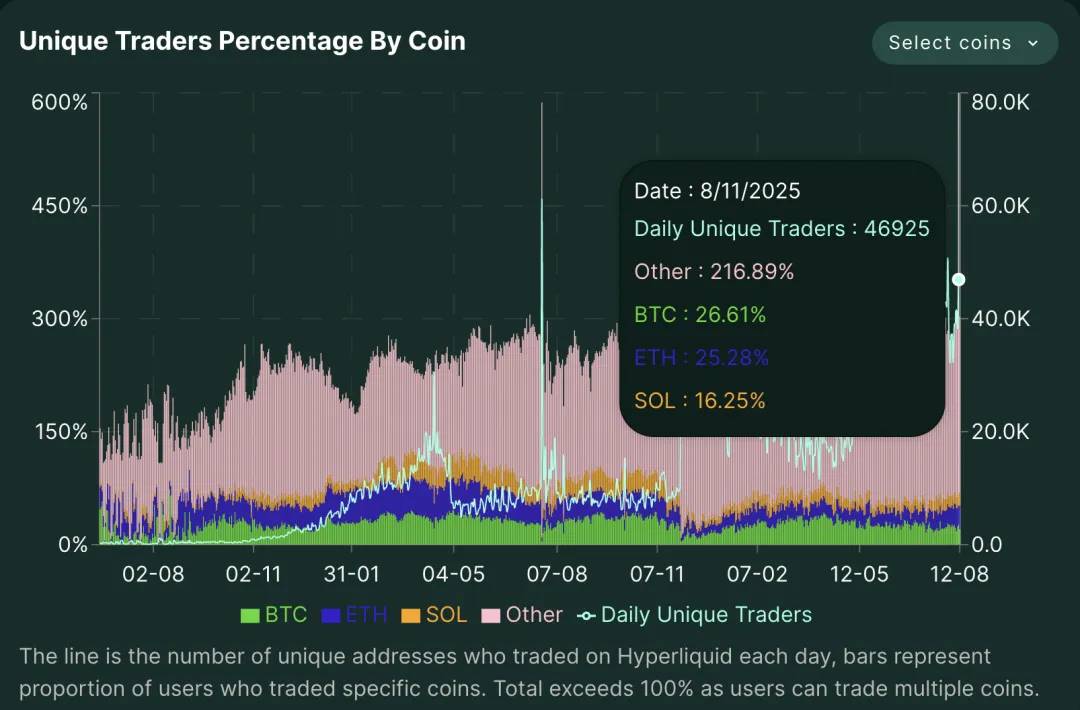
So, what does this mean?
At present, all aspects seem to heavily rely on bringing users into the HyperCore infrastructure and then somehow returning value to the ecosystem:
HyperEVM will bring more trading volume to Hyperliquid + a stable financialized layer.
Builder Codes help expand Hyperliquid's distribution channels, bringing fees back to the HYPE token.
HIP-3 will enable permissionless market creation and share fees with the HYPE token.
The inflation of the HYPE token will benefit stakers and generally bring higher yields to HyperEVM.
With the HYPE token as a perfect marketing tool and the best way to coordinate community development, Hyperliquid has formed a tightly-knit community resembling fervent believers. Ultimately, if leveraged trading is a valuable experience for consumers, then Hyperliquid's flywheel effect will continue to operate.
Wat Next?
Bearish Case
Possibility of Regulatory Tightening
Perpetual contracts provide end users with a channel to enter leveraged markets. Without robust KYC/anti-money laundering measures, there is a risk of money laundering. The platform may be forced to implement stricter compliance systems and report large transaction activities. Similar to Polymarket, U.S. users may ultimately need to go through KYC to use the platform.
Token Unlocking
If not handled properly, the locked airdrop supply could trigger significant selling pressure.
238 million core contributor tokens (accounting for 23.8% of total supply) will begin linear unlocking on November 29, 2025.
Based on current prices, it is expected to generate approximately $17.3 million in equivalent selling pressure daily between 2027 and 2028.
The proportion held by insiders will surge from the current 15.9% to 45.8% after full dilution.
Why it matters:
The current buyback capacity of the assistance fund is only about $2 million per day.
This creates a selling pressure 8.6 times the buyback capacity.
The timing overlaps with the downward cycle following the Bitcoin halving in 2027–2028.
To maintain price equilibrium, a 6–7 times increase in fee revenue is required.
Liquidity Diversion Risk
With the emergence of numerous new distribution forms (such as Builder Codes and markets created by HIP-3) on Hyperliquid L1, there is a risk that trading volume may flow to other markets. Although fees will ultimately flow back to the HYPE token (but the sharing ratio may be discounted), and Hyperliquid controls the core markets and distribution channels, this risk still exists.
Diminishing Returns of Buyback Effect and Risk of Flywheel Breakage
The buyback's effect on price appreciation exhibits diminishing returns. If Hyperliquid's adoption rate and the revenue generated by its products cannot match the market's demand for growth or the opportunity cost of holding other tokens, it may break the growth flywheel effect (macro trends may also suppress prices, as seen in April 2025). The mitigating factor lies in economic game theory: if the price falls to a sufficiently low market cap, buybacks will consolidate and push prices back up. However, the core risk is how many users are using the platform solely because of the HYPE token.
Security and Trust Comparison
While retail users appreciate Hyperliquid's user experience, they still prefer to store assets on Ethereum—due to its more robust validator set (800,000 vs. HL's mere 16), longer security track record, and stricter penalty mechanisms (HL's consensus design is secure, but it is more centralized, and penalty risks are more concentrated). Incidents like $JELLYJELLY have also raised community concerns about security and governance.
Lack of Development Funds
With 97% of fees used for buybacks, there is zero budget for growth, marketing, or security incentives. Any attempt to divert funds through governance proposals to finance development would be a double negative for token holders. Competitors are actively funding ecosystem development, while Hyperliquid finds itself in a "starvation" state.
Bullish Case
Growth Drivers
Attracting significant capital inflow through EVM integration and better interoperability.
HIP3 markets bringing traditional financial capital inflow from institutions and retail.
Continuous increase in the number of perpetual contract markets on the main site.
38.8% of tokens reserved for airdrops providing growth ammunition.
USDH Revenue Potential
The platform has approximately $5 billion in USD deposits, and with the introduction of USDH, it could generate $150-200 million annually based on current U.S. Treasury rates. If this revenue, previously retained by Circle, can be redirected to HYPE buybacks, it would be extremely beneficial for the ecosystem.
Cross-Chain Expansion
Achieving one-click deposits from any LayerZero chain, with initial assets including USDT0, USDe, PLUME, and COOK. Breaking the single-chain ceiling and strategically positioning for L2 order flow capture.
Fee Advantage
Current fee rate is about 2.8 basis points, while competitors are around 1 basis point.
Zero Gas orders + on-chain matching provide a sustainable profit model.
Even if fees are halved, profitability can still be maintained.
Opportunity from CEX Trust Crisis
Incidents at centralized exchanges (like FTX) have damaged their image. Hyperliquid, as a semi-trustless neutral infrastructure, promotes blockchain ideals with a CEX-like experience, narrowing the gap in custody decentralization, operational costs, and regulatory arbitrage.

However, directly comparing spot trading volume with perpetual contract trading volume is like comparing apples and oranges. If we want to clearly distinguish the actual market shares of Binance and Hyperliquid in the spot and perpetual contract markets, we can see the following:
Daily Trading Volume (September 9, 2025)

30-Day Trading Volume

Based on Messari's total monthly trading volume of $730 billion and daily ratio estimates.
The market positioning of the two is entirely different. One primarily serves off-chain users, while the other targets on-chain users. The following chart illustrates their dominance in their respective fields.
User Base Analysis

Trading Intensity

Based on a rough estimate of 25 million active users.
Market Share
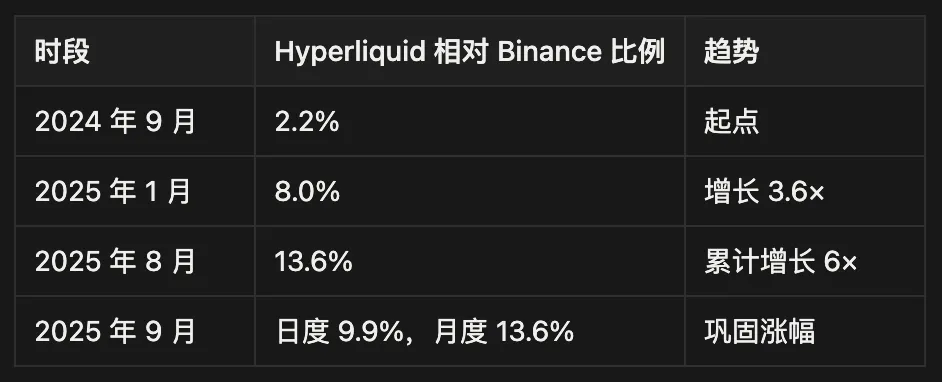
So far, all the builders I have interacted with in the Hyperliquid ecosystem are hardworking, value-creating, and community-driven teams. The formation of this atmosphere largely stems from the ecosystem's guidance from product to airdrop and everything in between.
To bring cryptocurrency to the masses, this field needs to create new value and better experiences for potential retail new users. Fundamentally, I believe Hyperliquid can provide a wealth of such products.
For example:
An excellent trading interface (on-chain version of Robinhood): capable of accessing on-chain liquidity while providing a seamless financial experience. If the crypto market wants to create a better financial structure, we also need a better interactive portal to abstract away the confusing UI/UX.
Pre-IPO products: With the ICO/TGE (Token Generation Event) of $PUMP, we see that the pre-market facilitated on perpetual contract exchanges allows users to speculate on it while providing better price discovery mechanisms for the underlying assets. If this is replicated for Pre-IPO assets, it would be an intuitive way to provide genuine value arbitrage (this tweet explains it well: https://x.com/j0hnwang/status/1947330391590752532).
Addressing fragmentation: With the emergence of many new markets (HIP3, other CLOBs, etc.), we see that liquidity and user experience may gradually become fragmented. Projects like https://superstack.xyz provide a great solution, just as 1inch does for DEXs, Jumper does for cross-bridging, and Beefy does for yield farming.
Real World Assets (RWA): HIP3 provides a way for off-chain assets like SPX to be accounted for on-chain. Other forms of RWA will provide more sustainable, income-backed yields and financial activities, which will help drive the ecosystem's development.
In summary, Hyperliquid takes a user-centric approach. From the core team's product decisions to the thousands of builders aligned with the vision, the entire ecosystem's design ensures that the ultimate winners will be those who create value rather than extract it. Newcomers now have an equal opportunity to prove their insights without being troubled by bad actors and can access a rich and mature ecosystem. Whether any product can survive through a bear market cycle is a mystery to anyone, but personally, I am very hopeful about their ability to rebound and continue attracting more builders.
This is not a bet on the price of HYPE rising or maintaining high yields—but a bet that building real businesses with real users and real revenue will ultimately win, even if the path includes significant volatility and user attrition.
The market is likely to give you multiple opportunities to accumulate this thematic asset at distressed prices. The question is whether you believe that in the long-term evolution of cryptocurrency, business acumen and sustainable revenue models will ultimately be more important than short-term token games.
There is ample room for development, but like any venture capital, I believe it is in the right hands.
免责声明:本文章仅代表作者个人观点,不代表本平台的立场和观点。本文章仅供信息分享,不构成对任何人的任何投资建议。用户与作者之间的任何争议,与本平台无关。如网页中刊载的文章或图片涉及侵权,请提供相关的权利证明和身份证明发送邮件到support@aicoin.com,本平台相关工作人员将会进行核查。




